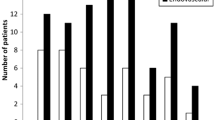Summary
An analysis of 251 patients who were hospitalized within 24 hours after rupture of supratentorial aneurysms and were not comatose during the very early stage was carried out. The patients were divided into three groups in relation to timing and methods of surgery. In 61 patients of Group A, the operation was planned to be delayed more than 10 days from subarachnoid haemorrhage (SAH). In 91 patients of Group B, clipping of aneurysms was performed within 48 hours of SAH and subarachnoid blood clots were simultaneously removed while approaching the aneurysms. In 99 patients of Group C, clipping of aneurysms was performed within 48 hours of SAH and radical and extensive removal of any subarachnoid blood clot identified on the computerized tomographic scan was tried at the same time. The outcome at 3 months after SAH was the most favourable in Group C patients and the least favourable in Group A patients.
Early operation combined with radical removal of subarachnoid clots minimizes the overall mortality and morbidity in patients with ruptured intracranial aneurysms by preventing rebleeding and probably by avoiding vasospasm.
Similar content being viewed by others
References
Adams, H. P., jr., Kassell, N. F., Torner, J. C., Nibbelink, D. W., Sahs, A. L., Early management of aneurysmal subarachnoid hemorrhage. A report of the cooperative aneurysm study. J. Neurosurg.54 (1981), 141–145.
Fisher, C. M., Kistler, J. P., Davis, J. M., Relation of cerebral vasospasm to subarachnoid hemorrhage visualized by computerized tomographic scanning. Neurosurgery6 (1980), 1–9.
Hori, S., Suzuki, J., Early intracranial operations for ruptured aneurysms. Acta neurochir. (Wien)46 (1979), 93–104.
Kosnik, E. J., Hunt, W. E., Postoperative hypertension in the management of patients with intracranial arterial aneurysms. J. Neurosurg.45 (1976), 148–154.
Ljunggren, B., Brandt, L., Kågström, E., Sundberg, G., Results of early operations for ruptured aneurysms. J. Neurosurg.54 (1981), 473–478.
Pool, J. L., Early treatment of ruptured intracranial aneurysms of the circle of Willis with special clip technique. Bull. N.Y. Acad. Med.35 (1959), 357–359.
Sano, K., Saito, T., Timing and indication of surgery for ruptured intracranial aneurysms with regard to cerebral vasospasm. Acta neurochir. (Wien)41 (1978), 49–60.
Sundt., T. M., jr., Cerebral vasospasm following subarachnoid hemorrhage: evolution, management, and relationship to timing of surgery. Clin. Neurosurg.24 (1977), 228–239.
Wilkins, R. H., The role of intracranial arterial spasm in the timing of operations for aneurysms. Clin. Neurosurg.24 (1977), 185–207.
Yaşargil, M. G., Fox, J. L., The microsurgical approach to intracranial aneurysms. Surg. Neurol.3 (1975), 7–14.
Yoshimoto, T., Uchida, K., Kaneko, U., Kayama, T., Suzuki, J., An analysis of follow-up results of 1000 intracranial saccular aneurysms with definitive surgical treatment. J. Neurosurg.50 (1979), 152–157.
Author information
Authors and Affiliations
Rights and permissions
About this article
Cite this article
Taneda, M. The significance of early operation in the management of ruptured intracranial aneurysms—An analysis of 251 cases hospitalized within 24 hours after subarachnoid haemorrhage. Acta neurochir 63, 201–208 (1982). https://doi.org/10.1007/BF01728873
Issue Date:
DOI: https://doi.org/10.1007/BF01728873




